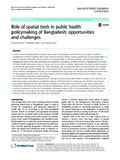Cross-country analysis of strategies for achieving progress towards global goals for women’s and children’s health

View/Open
Date
2016-02-21Publisher
© Bulletin of the World Health Organization 2016Author
Ahmed, Syed MasudRawal, Lal B.
Chowdhury, Sadia A.
Murray, John
Arscott-Mills, Sharon
Jack, Susan
Hinton, Rachael
Alam, Prima M.
Kuruvilla, Shyama
Metadata
Show full item recordCitation
Ahmed, S. M., Rawal, L. B., Chowdhury, S. A., Murray, J., Arscott-Mills, S., Jack, S., … Kuruvilla, S. (2016). Cross-country analysis of strategies for achieving progress towards global goals for women’s and children’s health. Bulletin of the World Health Organization, 94(5), 351–361. https://doi.org/10.2471/blt.15.168450Abstract
OBJECTIVE:
To identify how 10 low- and middle-income countries achieved accelerated progress, ahead of comparable countries, towards meeting millennium development goals 4 and 5A to reduce child and maternal mortality.
METHODS:
We synthesized findings from multistakeholder dialogues and country policy reports conducted previously for the Success Factors studies in 10 countries: Bangladesh, Cambodia, China, Egypt, Ethiopia, the Lao People's Democratic Republic, Nepal, Peru, Rwanda and Viet Nam. A framework approach was used to analyse and synthesize the data from the country reports, resulting in descriptive or explanatory conclusions by theme.
FINDINGS:
Successful policy and programme approaches were categorized in four strategic areas: leadership and multistakeholder partnerships; health sector; sectors outside health; and accountability for resources and results. Consistent and coordinated inputs across sectors, based on high-impact interventions, were assessed. Within the health sector, key policy and programme strategies included defining standards, collecting and using data, improving financial protection, and improving the availability and quality of services. Outside the health sector, strategies included investing in girls' education, water, sanitation and hygiene, poverty reduction, nutrition and food security, and infrastructure development. Countries improved accountability by strengthening and using data systems for planning and evaluating progress.
CONCLUSION:
Reducing maternal and child mortality in the 10 fast-track countries can be linked to consistent and coordinated policy and programme inputs across health and other sectors. The approaches used by successful countries have relevance to other countries looking to scale-up or accelerate progress towards the sustainable development goals.
Description
This article was published in the Bulletin of the World Health Organization, Population and Nutrition [© 2016 by Bulletin of the World Health Organization ] and the definite version is available at : http://dx.doi.org/10.2471/BLT.15.168450. The Journal's website is at: http://www.who.int/bulletin/volumes/94/5/15-168450/en/Publisher Link
http://www.who.int/bulletin/volumes/94/5/15-168450/en/Type
ArticleCollections
- Article [1]
- Article [11]
- Journal Articles (2016) [10]
